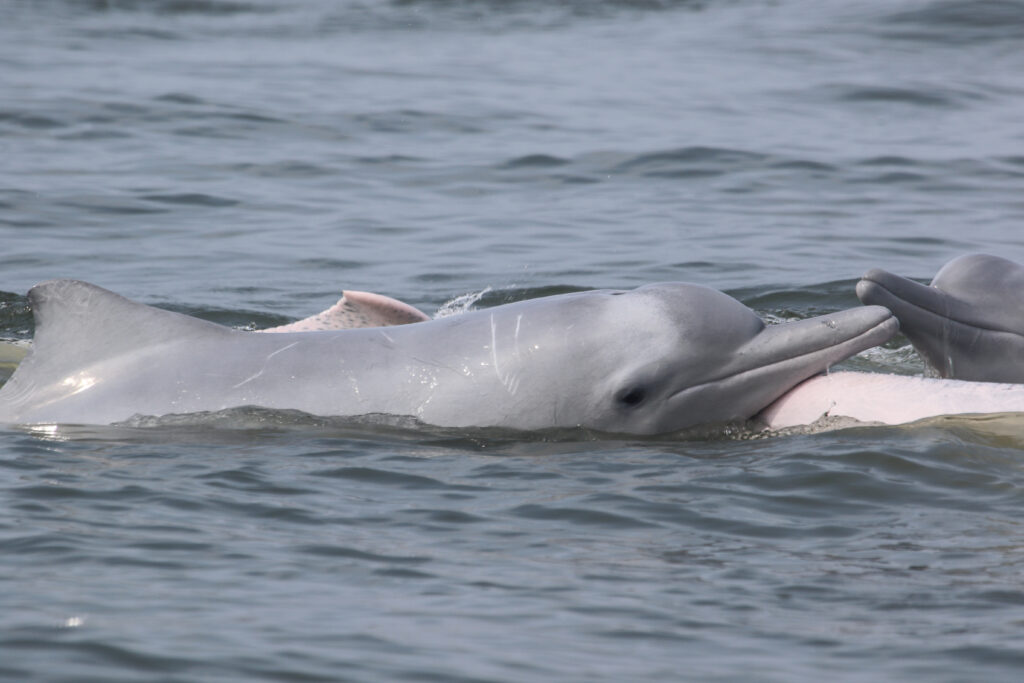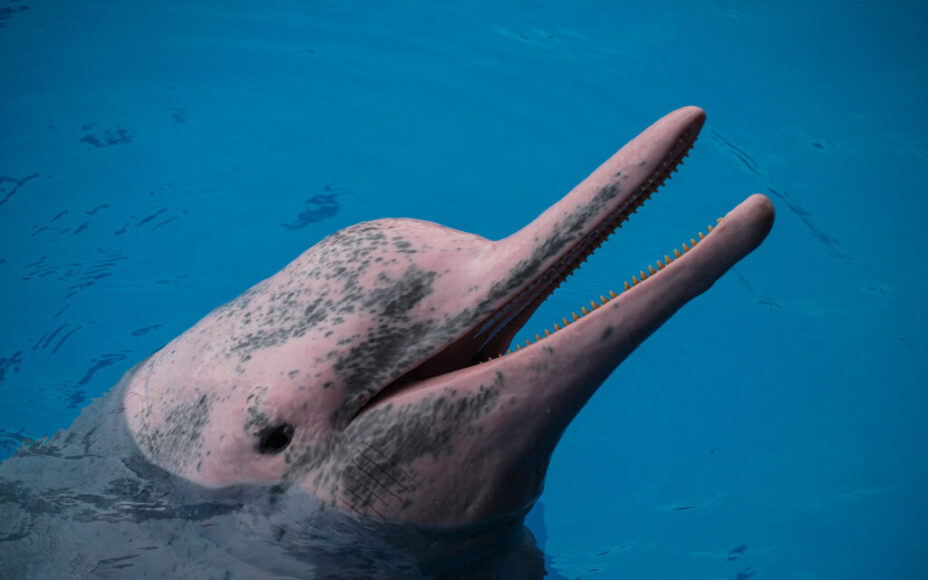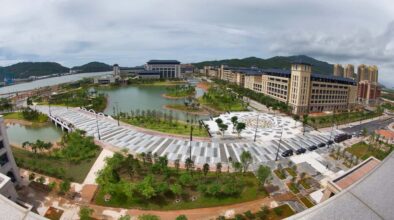Ken Kwan is a Macao-born wildlife conservationist who conducts regular surveys at observation points along Coloane’s Long Chao Kok Coastal Trail. Hugging the shoreline south of Hac Sa Beach, this popular hike is known for its large rock formations and stunning sea views. It’s also a reliable place to spy Chinese white dolphins – perhaps the most iconic marine mammal roaming the Pearl River Estuary. In spite of its name, the species is best-known for its bubblegum pink skin, though colouration does vary by individual.
Kwan recalls feeling his anxiety levels rise while out on an observation mission last year, as he hadn’t seen a dolphin in four days. Then, out of nowhere, two distinctive dorsal fins broke the water’s surface just 10 metres offshore. As he watched, he realised they belonged to a pod of five dolphins, including a calf. The sight made his heart soar.
The group swam as close as 3 metres from the shore, Kwan recalls. The 27-year-old could tell they were chasing fish, and was close enough to hear the whooshing sounds as they exhaled through their blowholes. He even believes he locked eyes with one curious individual.
“They put on a great show of breaching, which is a hunting behaviour when they break out of the water then crash down hard on the water’s surface,” Kwan recounts to Macao magazine. “Witnessing that, on that day, was one of the most magical encounters of my life.”
The Chinese white dolphin, also known as the Indo-Pacific humpback dolphin, is classified as a first-class state-protected species in China and as ‘vulnerable’ on the International Union for Conservation of Nature’s Red List. The species shares these statuses with giant pandas, sperm whales, sun bears and snow leopards, among others. First-class state protection is the highest level of legal protection wildlife can get under China’s Wildlife Protection Law, in place to preserve the country’s precious natural heritage.
While a Chinese white dolphin was used as a mascot during Hong Kong’s return to the motherland in 1997, the species is also a familiar sight in Macao, where pods swim in waters off the city’s eastern and southern coastlines. The dolphins, whose core habitat spans from the Macau International Airport to southern Coloane, hold a special place in the hearts of Macao residents.
A fateful encounter

Kwan’s journey into marine conservation began in his childhood. He explains it as a calling in part predestined by his Chinese name, Hok In, which means ‘to learn from nature’. “I was also just fascinated by wild animals,” he says. “Chasing insects and reading animal books were my favorite pastimes.”
After completing degrees in conservation and wildlife biology in Australia, Kwan returned to Macao to dedicate his skills to protecting local fauna – whether it be bird, reptile or sea creature. Kwan’s interest in Chinese white dolphins began in 2019, after spying a mother dolphin and her calf for the first time, near Long Chao Kok. “Seeing such majestic and vulnerable animals in my hometown meant a lot to me,” he recalls. “It solidified my commitment to their conservation.”
Since then, Kwan has focussed on finding out all he can about this unique dolphin species. The mission has brought him in close contact with Macao’s fishermen, whom he says have taught him a lot about the dolphins’ habits. The dolphins are known to follow fishing boats, snapping up any fish and shrimp that escapes the nets.
His research also involves systematic surveys conducted from land-based observation points like those along Long Chao Kok. Using binoculars and a camera equipped with a telephoto lens, Kwan meticulously scans the water for unusual movements and pale dorsal fins. Every time the conservationist spots a dolphin, he makes a record – jotting down the time and exact location, along with details like how many individuals were present, how old they appeared to be, and what they were doing.
Between January and June 2024, Kwan recorded 21 groups of dolphins. Most appeared to be hunting for seasonal prey, socialising and finding a mate – behaviours Kwan knew were associated with migration. “My findings are consistent with previous studies, which proves that the area is an important migratory corridor for the dolphins,” he says.
Dolphins of the Pearl River
While Chinese white dolphins are not exclusive to China (the species also inhabits the Indian Ocean and the western Pacific Ocean), they are mainly found in the country’s waters. The World Wildlife Fund (WWF) Hong Kong estimates that the population of Chinese white dolphins in the Pearl River Estuary is around 2,500 individuals, meaning it has the highest concentration of Chinese white dolphins in all of China. The area also boasts six out of the country’s seven dedicated Chinese White Dolphin Nature Reserves.
The purpose of these reserves goes beyond protecting the dolphins, however. They also aim to prevent land-based pollutants entering the sea, promote the creation and restoration of mangroves, protect coral reefs and seagrass beds, and ensure the sustainable use of fishery resources.
Chinese white dolphins are born dark gray, but quickly lighten and develop spots as they mature. The spots eventually fade into a pearly pink hue that can appear almost white in certain lights. Interestingly, the dolphins’ colour is not due to pigment in their skin – but from overdeveloped blood vessels just beneath their epidermis, which play a crucial role in regulating their body temperature. The effect is similar to a human’s blush. Chinese white dolphins share their colouration with the Amazon river dolphin, a freshwater species in South America.
Typically found in close-knit groups of four or so individuals, the Pearl River Estuary species is notable for its keen intelligence and intensely gregarious lifestyle. While youngsters are known to be especially playful, adults are also high-spirited and frolicsome. The animals appear to enjoy tail-slapping, swimming along on their sides, leaping out of the water to land with a splash, and something called ‘spy hopping’ – where they poke their heads and often flippers out of the sea to survey their surroundings.
Before their calves are weaned, mother dolphins appear to take teaching their babies the facts of life very seriously. Kwan once witnessed what he believes was a dolphin lesson, where a mother materialised with her calf about 300 metres offshore from where he was standing. The pair swam past Kwan’s observation point, then the mother suddenly made a sharp U-turn and swam directly towards him – her baby, less than a year old, following closely behind.
“They lingered about 10 or 15 metres offshore, surfacing together several times before heading south again,” he recalls. “I think the mother dolphin did this deliberately; she was probably teaching the calf a lesson about what a human looks like.”
Once weaned, the calves leave their mums to interact with dolphins from outside their original pod, and eventually either join or form new groups. Chinese white dolphins do not typically mate for life.
The thrill of the chase
Viena Mak, vice-chair of the Hong Kong Dolphin Conservation Society (HKDCS), has been studying Chinese white dolphins since 2012. One of the 33-year-old Macao-born conservationist’s favourite parts of monitoring the mammals watching them hunt. “The dolphins swim forward, lean right and left, and sometimes circle quickly, never moving in one straight direction,” she describes to Macao magazine. Mak says that observing the interactions between predator and prey is always a thrill.
To track the dolphins, Mak climbs mountains (for a better view of the sea) and wades through water (to get up close). She’s become so familiar with the individuals hanging out in local waters, that she can identify several of them based on the shapes of their dorsal fins, color patterns and scars.
While most of her research has been conducted in Hong Kong, Mak also collaborates with Kwan to observe dolphins in the waters of Macao. On one memorable occasion, the pair witnessed dolphins breaching multiple times as they chased fish towards the shore.
‘Our friends and neighbours’

Despite their intelligence, Chinese white dolphins face challenges. According to Mak, these include pollution from industrial waste and debris, and underwater noises that disrupt their ability to communicate and echolocate (dolphins identify an object’s location by reflected sound, a process known as echolocation). Fortunately, both Kwan and Mak have observed growing public interest in the dolphins in recent years – in part through their own, and their peers’, efforts.
For instance, HKDCS has been raising awareness through sharing infographics about the dolphins on social media. The society also collaborates with different companies and schools in Macao, promoting hands-on conservation to local children and their parents.
Kwan is a passionate proponent of ecological education and facilitates a myriad of activities around this theme in Macao. He leads bird watching expeditions, wildlife tours under the moonlight and wetland explorations, for starters. One of Kwan’s tours is at Coloane’s Pavilion of Animal Specimens, which boasts the skeleton of a Chinese white dolphin. In all these educational initiatives, Kwan’s aim is to get people reflecting on the close-knit relationship between humans, flora and fauna.
He goes so far as to describe dolphins as the “true indigenous people of Macao”, poetically emphasising the marine mammals’ historical presence in the region and the importance of ecological stewardship. According to Kwan, “they are our friends and neighbours.”



